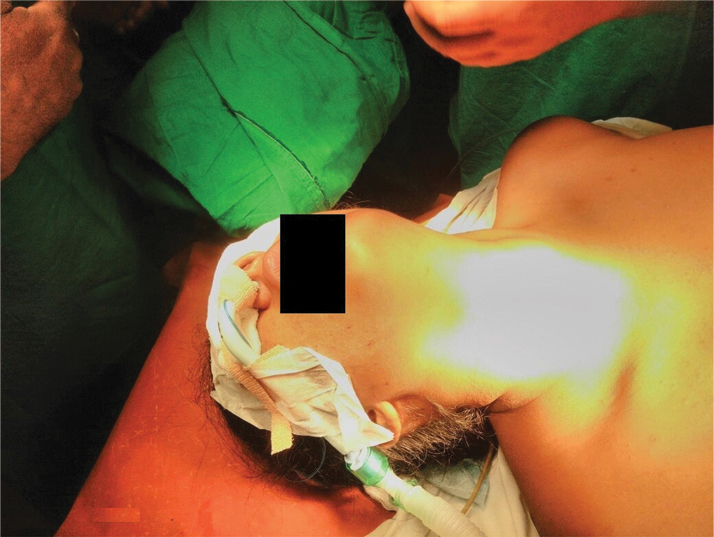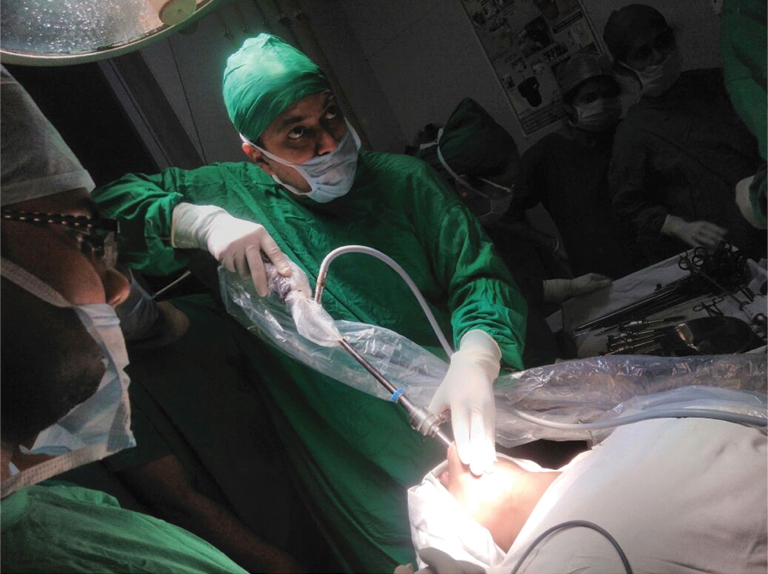Anaesthetic Management in Transoral Endoscopic Thyroidectomy
Rajendra D Patel1, Nisha Gowani2, Manali Nadkarni3, Sameer Rege4, Priti Devalkar5
1 Associate Professor, Department of Anaesthesiology, Seth GSMC and KEM Hospital, Mumbai, Maharashtra, India.
2 Junior Resident, Department of Anaesthesiology, Seth GSMC and KEM Hospital, Mumbai, Maharashtra, India.
3 Associate Professor, Department of Anaesthesiology, Seth GSMC and KEM Hospital, Mumbai, Maharashtra, India.
4 Associate Professor, Department of General Surgery, Seth GSMC and KEM Hospital, Mumbai, Maharashtra, India.
5 Assistant Professor, Department of Anaesthesiology, Seth GSMC and KEM Hospital, Mumbai, Maharashtra, India.
NAME, ADDRESS, E-MAIL ID OF THE CORRESPONDING AUTHOR: Dr. Nisha Gowani, Flat No 12, 2nd Floor, Aga Ali Manor, Aga Hall, Mazgaon, Mumbai-400010, Maharashtra, India.
E-mail: nishaseventeen@gmail.com
Young females undergoing thyroid surgery are apprehensive about the surgical scar. This leads to the introduction of Transoral Endoscopic Thyroidectomy (TOET). TOET is gaining popularity for its minimally invasive and cosmetically sound approach to perform thyroidectomies in young patients. The surgical site being the mouth orifice poses a challenge to the anaesthesiologist to secure a definitive airway. The case report is that of a young female undergoing TOET for whom we have successfully performed nasal intubation with a North Pole ivory endotracheal tube (ET).
Anaesthesia, Nasal intubation, Natural orifice transluminal endoscopic surgery
Case Report
A 25-year-old married hyperthyroid female on carbimazole, presented with a swelling over the left side of the neck. Patient was clinically asymptomatic with thyroid function test within normal limits {free Triiodothyronine (T3)-3.5 pg/ml; free Thyroxine (T4)-2.2 ng/dl; Thyroid stimulating hormone (TSH)-1.2 mI U/l}. Ultrasonography revealed a 2 cm x 2 cm solitary thyroid nodule. The patient was posted for a TOET.
The patient took chlorhexidine gargles twice daily for three days prior to surgery. Pre-anaesthetically, glycopyrrolate 0.2 mg was given Intravenously (IV). Pulse oximetry, noninvasive blood pressure and electrocardiogram were attached to patient and baseline readings were noted. Two 20 gauge IV cannulas were secured along with a 100 cm venous extension in right and left hands and co-loading of IV Ringer lactate was started. The patient was positioned supine, neck extended with a bolster placed below the shoulders. Both arms were tucked in on either side. The anaesthesia machine was placed to the right of the table [Table/Fig-1].
Patient is in supine position with neck extended. Preformed ivory nasal endotracheal tube is fixed on the right side away from surgical site.

The patient was preoxygenated for three minutes with oxygen at 4 L/minute. IV induction was done with midazolam 0.05 mg/kg, fentanyl 2 mcg/kg and propofol 2 mg/kg slowly. Vecuronium 0.1 mg/kg was given IV. Right nasal intubation by direct laryngoscopy done with pre-lubricated 7 mm North Pole Ivory cuffed ET tube. The ET tube was held with Magill’s and guided through the vocal cords. The cuff was inflated, tube was fixed and attached to a catheter mount, which was fixed on the side of the patients face with micropore tape. Moist roller gauze throat pack was done. Eyes were lubricated, taped and padded to avoid inadvertent trauma to eyes.
General anaesthesia was maintained with oxygen at 1.2 L/minute, nitrous oxide at 1.2 L/minute and 1-1.5 volume % isoflurane, minimum alveolar concentration was maintained at 1. Pressure controlled ventilation provided with respiratory rate of 12/minute, inspiratory pressure of 12 mmHg and peak end expiratory pressure of 5 mmHg. Intraoperative End Tidal Carbon Dioxide (ETCO2) ranged 35 mmHg-40 mmHg.
The inferior gingivolabial sulcus was given a betadine wash and local infiltration was given with 3 ml of 2% lignocaine (preservative free). One midline and two paramedian ports were made. Carbon dioxide was insufflated with 6 mmHg pressure and surgical steps were carried out, including stay sutures for retraction of strap muscles.
After completion of surgery, throat pack was removed and oral suctioning was done. ET tube suctioning was done. Reversal of neuromuscular block was done with neostigmine 0.05 mg/kg and atropine 10 mcg/kg.
Discussion
Surgical advances have lead to the development of Natural Orifice Transluminal Endoscopic Surgery (NOTES) which results in a scarless surgery [1]. Our patient was a young female who expressed a similar concern regarding the surgical scar just as the patient mentioned in the report prepared by Pai VM et al., [2]. The transaxillary and transareolar planes require more dissection and also leave small scars on the port site, while the oral vestibule approach is scarless and requires lesser dissection, thus TOET was performed [3]. To improve ergonomics, a 100 cm venous extension was attached to the IV cannula ensuring that the anaesthesiologist standing at the foot end of the patient had access to the line and could administer drugs and fluids with ease, the anaesthesia machine was stationed to the side of the table. The surgeons were positioned at the head end of the patient making access to the airway difficult for the anaesthesiologist, thus the ET tube catheter mount assembly was fixed to one side away from the surgical field [Table/Fig-1].
Similar to Nakajo A et al., and Anuwong A et al., our patient was positioned supine with the neck extended [4,5]. Pai VM et al., and Anuwong A et al., have performed Nasal intubation for TOET, whereas Lee JH et al., have performed nasal intubation for NOTES [2,5,6]. Our patient was intubated with pre-lubricated 7 mm cuffed preformed North Pole ivory ET tube. North Pole tube is not prone to kinking due to its pre-shaped form unlike the oral tube. Also, the tube does not come in way of the surgical field, as the endoscopes are introduced from the mouth [Table/Fig-2]. The oral tube occupies space in the surgical field and is also more prone to get displaced during surgical manipulations. Nakajo A et al., had an oral ET tube placed in situ [4].
Surgeon is positioned at head end of patient while performing transoral endoscopic thyroidectomy.

Throat pack placed to avoid aspiration risk and the eyes have been padded, thus protecting them. The CO2 was insufflated at a pressure of 6 mmHg in the subplatysmal plane. A close check was kept on ETCO2, a rising trend was noted and the highest reading encountered was of 40 mmHg. Absorption of CO2 during extraperitoneal insufflation is higher than intra-peritoneal insufflation.CO2 insufflation in abdominal laparoscopic surgeries ranges from 10 mmHg-15 mmHg which can lead to rise in ETCO2, increase in partial pressure of arterial CO2, CO2 embolism, subcutaneous emphysema, due to absorption from the large surface area of the peritoneum and high insufflating pressures [7]. The arterial blood gas analysis done one hour postinduction was within normal limits.
Nakajo A et al., performed a gasless video assisted thyroidectomy, using K wires, thus eliminating the risks involved with CO2 [4]. The airway pressures required during ventilation for TOET is significantly lower than that required for abdominal laparoscopic surgeries. The features that make TOET attractive are the shorter duration of surgery, minimal blood loss, fewer complications, quick recovery, lesser duration of hospital stay and no surgical scar. The use of magnified stereoscopic visualization allows for more meticulous dissection and bleeding control [5]. The patient was successfully extubated, had minimal pain, did not require narcotic medications and was discharged the next day.
The total duration of procedure was 90 minutes, which is lesser than the bilateral axillary breast approach [8]. Thus, the duration for which CO2 is used is also lower.
Conclusion
The data available on anaesthesia management and techniques is limited. We have described the management of TOET without any particular complication. We would conclude that as an anaesthesiologist we should monitor closely the patient’s position, and the ETCO2, secure a nasal ET tube with throat packing and detect the associated respiratory and haemodynamic changes.
[1]. Clark MP, Qayed ES, Kooby DA, Maithel SK, Willingham FF, Natural orifice translumenal endoscopic surgery in humans: a reviewMinim Invasive Surg 2012 2012:189296 [Google Scholar]
[2]. Pai VM, Muthukumar P, Prathap A, Leo J, Rekha A, Transoral endoscopic thyroidectomy: A case reportInt J Surg Case Rep 2015 12:99-101. [Google Scholar]
[3]. Slotema ET, Sebag F, Henry JF, What is the evidence for endoscopic thyroidectomy in the management of benign thyroid disease?World J Surg 2008 32(7):1325-32. [Google Scholar]
[4]. Nakajo A, Arima H, Hirata M, Mizoguchi T, Kijima Y, Mori S, Trans-Oral Video-Assisted Neck Surgery (TOVANS). A new transoral technique of endoscopic thyroidectomy with gasless premandible approachSurg Endosc 2013 27(4):1105-10. [Google Scholar]
[5]. Anuwong A, Transoral endoscopic thyroidectomy vestibular approach: a series of the first 60 human casesWorld J Surg 2016 40(3):491-97. [Google Scholar]
[6]. Lee JH, Chung CJ, Lee SC, Shin HJ, Anesthetic management of transoral natural orifice transluminal endoscopic surgery: two cases reportKorean J Anesthesiol 2014 67(2):148-52. [Google Scholar]
[7]. Cunningham AJ, Laparoscopic surgery-anesthetic implicationsSurg Endosc 1994 8(11):1272-84. [Google Scholar]
[8]. Choe JH, Kim SW, Chung KW, Park KS, Han W, Noh DY, Endoscopic thyroidectomy using a new bilateral axillo-breast approachWorld J Surg 2007 31(3):601-06. [Google Scholar]